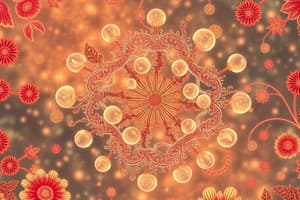Podcast
Questions and Answers
What is the distinctive bilayer membrane structure of mitochondria composed of?
What is the distinctive bilayer membrane structure of mitochondria composed of?
Outer membrane and inner membrane
What are the finger-like extensions on the inner membrane of mitochondria called?
What are the finger-like extensions on the inner membrane of mitochondria called?
Cristae
Where does the mitochondrial genome reside within the mitochondria?
Where does the mitochondrial genome reside within the mitochondria?
Mitochondrial matrix
What is the primary role of mitochondria in eukaryotic cells?
What is the primary role of mitochondria in eukaryotic cells?
What is the function of mitochondria in converting biochemical energy from food sources?
What is the function of mitochondria in converting biochemical energy from food sources?
Which organelle is often referred to as the 'powerhouse of the cell'?
Which organelle is often referred to as the 'powerhouse of the cell'?
What are the main components involved in cellular respiration?
What are the main components involved in cellular respiration?
How is mitochondrial DNA (mtDNA) inherited?
How is mitochondrial DNA (mtDNA) inherited?
What is the role of mitochondria in managing calcium levels?
What is the role of mitochondria in managing calcium levels?
What process occurs when pyruvate enters the mitochondria?
What process occurs when pyruvate enters the mitochondria?
How does the Electron Transport Chain (ETC) contribute to ATP production?
How does the Electron Transport Chain (ETC) contribute to ATP production?
What is the significance of the interaction between paternal and maternal contributions in mitochondrial function?
What is the significance of the interaction between paternal and maternal contributions in mitochondrial function?
Flashcards are hidden until you start studying
Study Notes
Mitochondria: An Introduction to Their Structure, Function, and More
Mitochondria are double-membraned organelles found in the cytoplasm of virtually every eukaryotic cell, from plants to animals. They are often referred to as the "powerhouses of the cell" due to their crucial role in generating most of the chemical energy needed to sustain life through the process of cellular respiration. Here, we will explore the key aspects of mitochondria, including their structure, function, Mitochondrial DNA (mtDNA), and their significance in cellular respiration.
Structure
Mitochondria exhibit a distinctive bilayer membrane structure composed of an outer membrane and an inner membrane. Between these layers lies the intermembrane space. The inner membrane is convoluted into finger-like extensions called cristae, which greatly increase the surface area of the inner membrane, providing more room for the proteins responsible for energy production. Inside the inner membrane is the mitochondrial matrix, where the mitochondrial genome resides along with various enzymatic systems vital for processing cellular substrates during energy generation.
Function
Mitochondria play several roles in eukaryotic cells. First and foremost, they engage in cellular respiration, converting biochemical energy from food sources into Adenosine Triphosphate (ATP), the currency of cellular energy. This occurs through a series of steps involving glycolysis, the Citric Acid Cycle (also known as the Krebs Cycle), and Electron Transport Chain (ETC) activity, culminating in a process called oxidative phosphorylation.
Additionally, mitochondria perform other important tasks. For instance, they regulate programmed cell death, manage calcium storage for cell signal transduction, and facilitate thermogenesis (body temperature regulation). Moreover, they are involved in the initiation of apoptosis, a form of controlled cell suicide. Some studies suggest that mitochondria might even possess 'intelligence', capable of sensing environmental conditions and responding appropriately without explicit instructions from the nucleus.
Mitochondrial DNA (mtDNA)
Unlike nuclear DNA, which encodes the full complement of proteins necessary for cell function, the mitochondrial genome carries only a subset of genes. Human mtDNA consists of 37 genes, including 22 transfer RNA (tRNA) genes, 2 ribosomal RNA (rrRNA) genes, and 13 protein-encoding genes, mostly for subunits of the ETC. Interestingly, mtDNA is inherited matrilineally, meaning it is passed down from mother to offspring. Because most of the proteins and other constituents of the mitochondria itself come from the cell nucleus, while only a fraction comes from the maternal mtDNA, a complete understanding of how the organelle functions requires considering the interaction between both paternal and maternal contributions.
Cellular Respiration
Cellular respiration begins when glucose enters the cell and is broken down through glycolysis into pyruvate, releasing ATP and CO₂ as waste products. Pyruvate then enters the mitochondria and is converted into acetyl-CoA, entering the Citric Acid Cycle to produce additional ATP. Finally, the ETC, located on the inner mitochondrial membrane, utilizes the flow of electrons generated by the breakdown of acetyl-CoA to pump protons out of the mitochondrial matrix, creating a proton gradient that drives the synthesis of ATP from adenosine diphosphate (ADP) by means of ATP synthase.
In summary, mitochondria are complex organelles whose structure and function are tightly linked to the energetic needs of the cell. From producing ATP to managing calcium levels, they are essential players in maintaining homeostasis and driving the processes that keep living things alive.
Studying That Suits You
Use AI to generate personalized quizzes and flashcards to suit your learning preferences.




